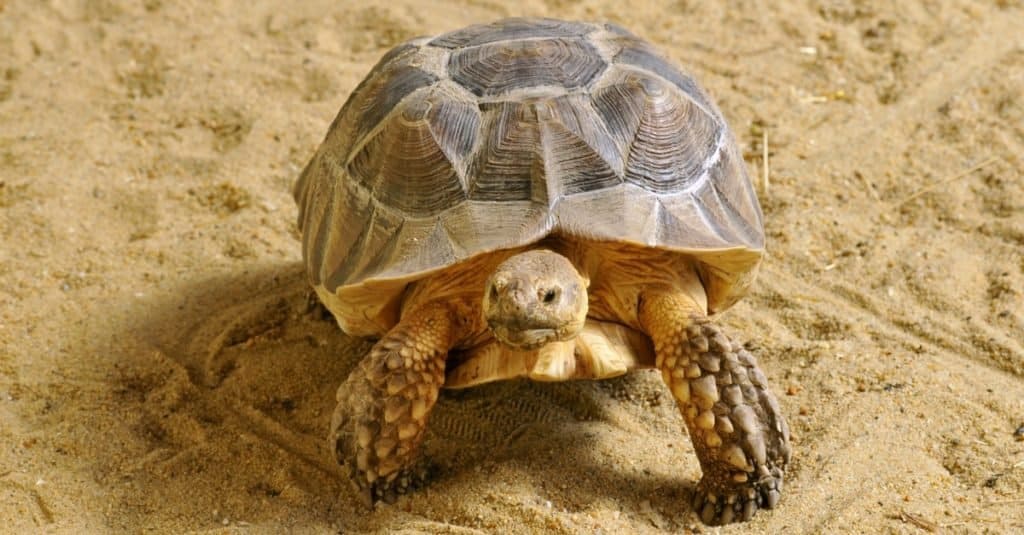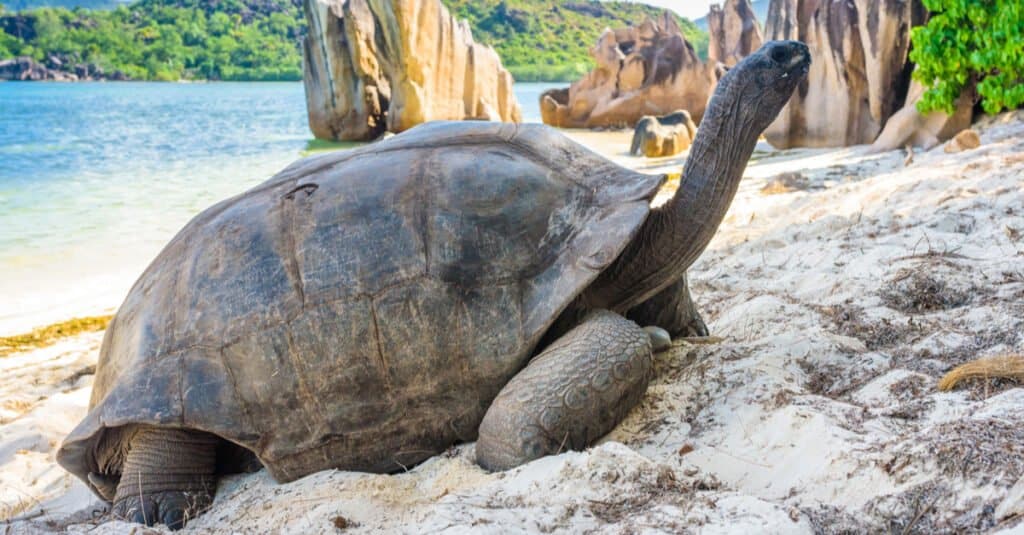Remember the story about the tortoise and the hare? “Slow and steady wins the race.” Tortoises have a reputation of being slow, but they also have a reputation of being big. Perhaps you’ve been to your local zoo and had pictures taken on top of a life-sized bronze tortoise sculpture. These gentle giants are fascinating creatures and have many unique characteristics. Did you know most of the tortoise’s weight is from its shell with some shells weighing over 500lbs! The giant tortoises are the largest of the tortoises and are spread across islands in Seychelles and the Galapagos islands. Let’s take a look at the three largest tortoises and the largest tortoise ever recorded!
3. The African spurred tortoise (sulcata tortoise) is the third largest tortoise

The African spurred tortoise is the largest tortoise that doesn’t live on remote islands.
©Christian Musat/Shutterstock.com
Although African spurred tortoises are not the largest in the world, they are the largest mainland tortoise (the other two live on islands). When it comes to animals that have backbones, did you know that turtles and tortoises are the only ones that have shells? A tortoise’s shell is made of a series of bones connected together and covered in keratin, the same material that our fingernails are made of. If you have seen a cartoon where a tortoise runs out of its shell, that is all just for fun because a tortoise’s shell is connected to its ribcage.
So how big do these tortoises (often also called sulcata tortoises) get? The males are bigger than the females and can grow to be 2 ½ feet long and weigh around 200lbs. Even though they are large animals they do not consume any meat, they are herbivores and live off the vegetation they can find in the deserts where they live, like grasses, flowers and cacti. Living in the desert also creates a situation where food and water may become scarce so the tortoises have adapted and can go for weeks without food or water.
To get out of the desert heat the African spurred tortoise will dig a burrow, a really deep burrow, sometimes as deep as 10 feet. They will spend the hot days in the burrow and come out at dusk and dawn to find food. Other animals benefit from these burrows and use older ones as shelter for themselves.
Like other tortoises, they have a long lifespan and can live to be 80-100 years!
2. The Aldabra giant tortoise is the second largest tortoise

Aldabra tortoises can reach up to 600 pounds and are the second largest tortoise in the world.
©Jan Bures/Shutterstock.com
The Aldabra giant tortoise lives on a series of islands in the Indian Ocean, on the Aldabra atoll which is a part of the Seychelles islands. They can primarily be found foraging around in the grasslands or near swamps and to cool off, these giants will find a shallow pool of water to find some respite. They look similar to African spurred tortoises but are bigger and have longer necks. They stretch their necks to reach leaves on higher branches. These herbivores live in a vegetation-rich environment so finding food is not difficult. They will eat leaves, grasses, herbs, fruit and berries.
Aldabra tortoises can grow to be 3-4 feet long and weigh between 330-550lbs; sometimes even pushing 600 pounds! According to the Oakland zoo (these tortoises are popular zoo animals) the Aldabra tortoise can stretch its neck up to three feet high! They sometimes will stand on their hind legs and lean up against a tree to reach some of the best leaves!
1. The Galapagos tortoise is the largest tortoise
The largest tortoise in the world is the Galapagos tortoise, which can weigh up to 919 pounds.
Galapagos tortoises live on seven of the Galapagos Islands and are often visited by tourists. There is a conservationist group on the island that helps raise these tortoises and release them back into the wild. The Charles Darwin Research Station raises these tortoises to help protect them from extinction which has occurred to other tortoises on the islands (there are roughly 15 species of Galapagos tortoises with three having gone extinct). One of the biggest threats to these animals is hawks that swoop down and snag the tortoise eggs. By protecting the eggs, conservationists can help these tortoises grow large enough where there are no predators.
There are two kinds or tortoise shells, the dome-shaped and saddle-shaped. The saddle-shape shell has a notch near the neckline and this allows the tortoise to stretch its neck up to reach leaves, similar to the Aldabra tortoise. Galapagos tortoises are also herbivores and eat a variety of grasses, leaves and cacti. Like other tortoises, they don’t need a lot of water and go for weeks without eating or drinking.
So how big are the largest tortoises? Their bodies can be as long as 6ft! Most are closer to 4-5ft long and can weigh between 550-650lbs with some of the heavier ones reaching 800lbs or more!
The largest tortoise ever was named Goliath
The largest tortoise ever was a Galapagos tortoise named ‘Goliath’ that reached 919 pounds!
The Guinness World Records has a record for the world’s largest tortoise with the record standing since 2002. A giant tortoise that originated from the Galapagos’ Santa Cruz Island was being raised from a hatchling at the Seffner’s Life Fellowship Bird Sanctuary in Seffner, Florida. Most tortoises reach their peak weight when they are around 30 years old, but Goliath just kept growing.
He started to draw attention in 1996 when he was weighed and came in at 849lbs, but he kept growing. The top recorded weight for Goliath was 919 lbs!! Not only is he the heaviest tortoise but he is the largest, he was 4ft 5inches long, 3ft 4inches long and 2ft 3inches tall.
Extinct giant tortoises: what was the largest tortoise to ever exist?
The largest “relative” of tortoises was Archelon, a sea turtle that weighed 4,900 pounds and was 13 feet wide! Archelon lived at the same time as dinosaurs. Modern sea turtles don’t turace their lineage back to Archelon, but it shows how big ancient turtles could grow to!
There used to be significantly more giant tortoise species, but many have unfortunately gone extinct. Giant tortoises can float and withstand long periods without food or water (some species can potentially go a year without either!). That makes tortoises adept at finding remote islands to populate that lack the kinds of predators that could successfully hunt these plodding giants. Once on islands, tortoises exhibit a phenomenon known as island gigantism. Another example of this phenomenon is how Komodo dragons have reached such incredible sizes by becoming the apex predator on a secluded island that lacked large mammalian predators.
Giant tortoises lived in locations like Madagascar not long ago. For example, the abrupt giant tortoise measured nearly four feet across and may have survived until about 1500. Giant tortoises also lived in the Canary Islands, on Malta, Bermuda, and across Caribbean islands like Cuba. However, today the only giant tortoise species left are in the Galapagos islands and Seychelles.
Giant Tortoise Fun Fact
Big and Old: Tortoises also have a long life span and one of the oldest recorded captive Galapagos’ tortoise reached the age of 169 years old! This grandma tortoise was named Harriet and lived in a zoo in Australia until 2006 when she passed away. Most tortoises have a life expectancy closer to 100. Another old (and big) tortoise named Esmerelda was from Bird Island in the Seychelles, she once held the record for the heaviest tortoise (weighing 800lbs) and was more than 170 years old.
The tortoise that may be the oldest tortoise ever is a tortoise named Jonathan that was from the island of Saint Helena in the South Atlantic Ocean. He’s a Aldabra giant tortoise as well and will celebrate his 190th birthday in 2022.
There are reports of tortoises that survived for centuries, such as a tortoise that was claimed to be 255 years old in Kolkata and a sulcata tortoise in Nigeria that was reportedly 344 years old. However, neither of these tortoises have documentation and its likely their long lifespans were anecdotal.
The photo featured at the top of this post is © Jan Bures/Shutterstock.com
Thank you for reading! Have some feedback for us? Contact the AZ Animals editorial team.






